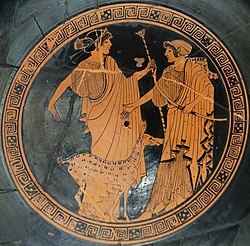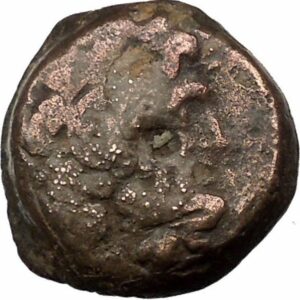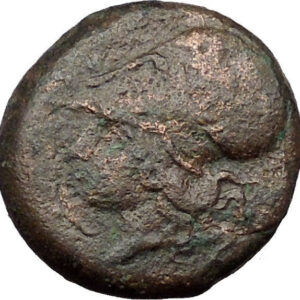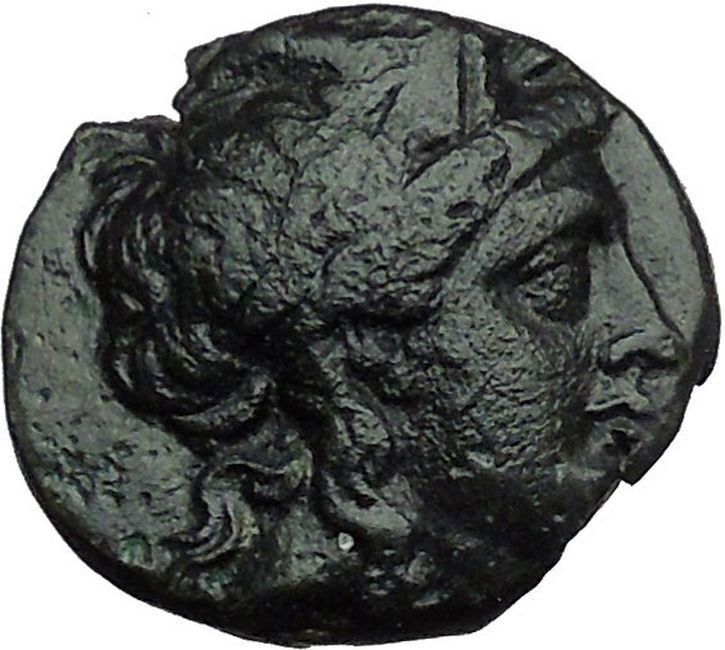|
Greek city of
Katane
in
Sicily
Bronze 16mm (2.71 grams) Struck after 212 B.C.
Reference: Calciati III, S. 110, Em. 25
Head of Apollo right.
KATANAIΩΝ,
Aphrodite
Hyblaia
standing right holding bird, II (mark of value)
before.
Following the capture by Hieron of Syracuse, in 476 B.C., the
name of this city was changed to Aitna; but on the expulsion of the the new
colonists, fifteen years later, the place reverted to its original name of
Katane. It was captured in 404 B.C. by Dionysios of Syracuse who sold the
population into slavery. Katane submitted to Rome during the First Punic War.
You are bidding on the exact
item pictured, provided with a Certificate of Authenticity and Lifetime
Guarantee of Authenticity.
Aphrodite is the
Greek
goddess
of
love, beauty
, and
sexuality
. Her
Roman equivalent
is the goddess
Venus
. Historically, her cult in
Greece was imported from, or influenced by, the

cult
of Astarte
in
Phoenicia
.
According to Hesiod
‘s
Theogony
, she was born when
Cronus
cut off
Uranus
‘ genitals and threw them into the sea,
and from the sea foam (aphros) arose Aphrodite.
Because of her beauty other gods feared that jealousy would interrupt the
peace among them and lead to war, and so
Zeus married her to
Hephaestus
, who was not viewed as a threat.
Aphrodite had many lovers, both gods like
Ares, and men like
Anchises
. Aphrodite also became instrumental in
the
Eros and Psyche
legend, and later was both
Adonis
‘ lover and his surrogate mother. Many
lesser beings were said to be children of Aphrodite.
Aphrodite is also known as Cytherea (Lady of Cythera) and
Cypris (Lady of Cyprus) after the two cult-sites,
Cythera
and
Cyprus
, which claimed her birth.
Myrtles
,
doves
,
sparrows
,
horses
, and
swans are sacred to her. The Greeks further identified the Ancient
Egyptian goddess Hathor
with Aphrodite.[4]
Aphrodite also has many other local names, such as Acidalia, Cytherea and Cerigo,
used in specific areas of Greece. Each goddess demanded a slightly different
cult but Greeks recognized in their overall similarities the one Aphrodite.
Attic philosophers of the fourth century separated a celestial Aphrodite (Aprodite
Urania) of transcendent principles with the common Aphrodite of the people
(Aphrodite Pandemos).
Katane in Sicily
Foundation
All ancient authors agree in representing Catania as a
Greek colony
named
Κατάνη (‘Katánē—see also
List of traditional Greek place names
) of
Chalcidic
origin, but founded immediately from
the neighboring city of
Naxos
, under the guidance of a leader named
Euarchos (Euarchus).
The exact date of its foundation is not recorded, but it appears from
Thucydides
to have followed shortly after that
of Leontini (modern
Lentini
), which he places in the fifth year
after
Syracuse
, or
730 BC
.
Greek
Sicily
The only event of its early history that has been transmitted to us is the
legislation of
Charondas
, and even of this the date is wholly
uncertain.
But from the fact that his legislation was extended to the other Chalcidic
cities, not only of Sicily, but of
Magna Graecia
also, as well as to his own
country, it is evident that Catania continued in intimate relations with these
kindred cities.
It seems to have retained its independence till the time of
Hieron of Syracuse
, but that despot, in
476 BC
, expelled all the original inhabitants,
whom he established at Leontini, while he repeopled the city with a new body of
colonists, amounting, it is said, to not less than 10,000 in number, and
consisting partly of
Syracusans
, partly of
Peloponnesians
.
He at the same time changed the city’s name to
Αἴτνη (Aítnē, Aetna or Ætna,
after the nearby
Mount Etna
, an active
volcano
), and caused himself to be proclaimed
the
Oekist
or founder of the new city. As such he
was celebrated by Pindar
, and after his death obtained heroic
honors from the citizens of his new colony.
But this state of things was of brief duration, and a few years after the
death of Hieron and the expulsion of
Thrasybulus
, the Syracusans combined with
Ducetius
, king of the
Siculi
, to expel the newly settled inhabitants
of Catania, who were compelled to retire to the fortress of
Inessa
(to which they gave the name of Aetna),
while the old Chalcidic citizens were reinstated in the possession of Catania,
461 BC
.
The period that followed the settlement of affairs at this epoch appears to
have been one of great prosperity for Catania, as well as for the Sicilian
cities in general: however, no details of its history are known till the great
Athenian
expedition to Sicily
(part of the larger
Peloponnesian War
).
On that occasion the Catanaeans, notwithstanding their Chalcidic connections,
at first refused to receive the Athenians into their city: but the latter having
effected an entrance, they found themselves compelled to espouse the alliance of
the invaders, and Catania became in consequence the headquarters of the Athenian
armament throughout the first year of the expedition, and the base of their
subsequent operations against Syracuse.
There is no information as to the fate of Catania after the close of this
expedition: it is next mentioned in
403 BC
, when it fell into the power of
Dionysius I of Syracuse
, who sold the
inhabitants as slaves, and gave up the city to plunder; after which he
established there a body of
Campanian
mercenaries.
These, however, quit it again in
396 BC
, and retired to
Aetna
, on the approach of the great
Carthaginian
armament under
Himilco
and
Mago
. The great sea-fight in which the latter
defeated
Leptines
, the brother of Dionysius, was fought
immediately off Catania, and the city apparently[ wordsweasel]
fell, in consequence, into the hands of the Carthaginians.
Callippus
, the assassin of Dion of Syracuse,
when he was expelled from Syracuse, for a time held possession of Catania (Plut.
Dion. 58); and when
Timoleon
landed in Sicily Catania was subject
to a despot named
Mamercus
, who at first joined the
Corinthian
leader but afterwards abandoned his
alliance for that of the Carthaginians, and was in consequence attacked and
expelled by Timoleon.
Catania was now restored to liberty, and appears to have continued to retain
its independence; during the wars of
Agathocles
with the Carthaginians, it sided at
one time with the former, at others with the latter; and when
Pyrrhus
landed in Sicily, Catania was the first
to open its gates to him, and received him with the greatest magnificence.
Catania was the birth-place of the philosopher and legislator Charondas; it
was also the place of residence of the poet
Stesichorus
, who died there, and was buried in
a magnificent sepulchre outside one of the gates, which derived from thence the
name of Porta Stesichoreia. (Suda,
under Στησίχορος.)
Xenophanes
, the philosopher of
Elea
, also spent the latter years of his life
there, so that it was evidently, at an early period, a place of cultivation and
refinement.
The first introduction of dancing to accompany the flute, was also ascribed
to
Andron
, a citizen of Catania
In ancient times Catania was associated with the legend of
Amphinomus and Anapias
, who, on occasion of a
great eruption of Etna, abandoned all their property, and carried off their aged
parents on their shoulders, the stream of lava itself was said to have parted,
and flowed aside so as not to harm them. Statues were erected to their honor,
and the place of their burial was known as the Campus Piorum; the
Catanaeans even introduced the figures of the youths on their coins, and the
legend became a favorite subject of allusion and declamation among the
Latin poets
, of whom the younger
Lucilius
and
Claudian
have dwelt upon it at considerable
length.
The occurrence is referred by
Hyginus
to the first eruption of Etna that took
place after the settlement of Catania.
Roman
rule
In the
First Punic War
, Catania was one of the first
among the cities of Sicily, which made their submission to the
Roman Republic
, after the first successes of
their arms in 263 BC. The expression of
Pliny
(vii. 60) who represents it as having
been taken by
Valerius Messalla
, is certainly a mistake.
It appears to have continued afterwards steadily to maintain its friendly
relations with Rome, and though it did not enjoy the advantages of a confederate
city (foederata civitas), like its neighbors Tauromenium (modern
Taormina
) and Messana (modern
Messina
), it rose to a position of great
prosperity under the Roman rule.
Cicero
repeatedly mentions it as, in his time,
a wealthy and flourishing city; it retained its ancient municipal institutions,
its
chief magistrate
bearing the title of
Proagorus; and appears to have been one of the principal ports of Sicily for
the export of corn.
It subsequently suffered severely from the ravages of
Sextus Pompeius
, and was in consequence one of
the cities to which a
colony
was sent by
Augustus
; a measure that appears to have in a
great degree restored its prosperity, so that in
Strabo
‘s time it was one of the few cities in
the island that was in a flourishing condition.
It retained its colonial rank, as well as its prosperity, throughout the
period of the
Roman Empire
; so that in the 4th century
Ausonius
in his
Ordo Nobilium Urbium
, notices Catania and
Syracuse alone among the cities of Sicily.
One of the most serious
eruptions
of
Mount Etna
happened in
121 BC
, when great part of Catania was
overwhelmed by streams of lava, and the hot ashes fell in such quantities in the
city itself, as to break in the roofs of the houses.
Catania was in consequence exempted, for 10 years, from its usual
contributions to the Roman state The greater part of the broad tract of plain to
the southwest of Catania (now called the Piana di Catania, a district of
great fertility), appears to have belonged, in
ancient times
, to Leontini or Centuripa (modern
Centuripe
), but that portion of it between
Catana itself and the mouth of the Symaethus, was annexed to the territory of
the latter city, and must have furnished abundant supplies of grain.
The port of Catania also, which was in great part filled up by the eruption
of
1669 AD
, appears to have been in ancient times
much frequented, and was the chief place of export for the corn of the rich
neighboring plains. The little river Amenanus, or Amenas, which flowed through
the city, was a very small stream, and could never have been navigable.

Apollo Belvedere
,
ca. 120–140 CE
Apollo is one of the most important and complex of the
Olympian deities
in
ancient Greek
and
Roman religion
,
Greek
and
Roman mythology
, and
Greco
–Roman
Neopaganism
. The ideal of the
kouros
(a beardless, athletic youth),
Apollo has been variously recognized as a god of light and the sun, truth and
prophecy, healing, plague, music, poetry, and more. Apollo is the son of
Zeus and Leto
, and has a twin sister, the chaste
huntress Artemis
. Apollo is known in Greek-influenced
Etruscan mythology
as Apulu.
As the patron of Delphi
(Pythian Apollo), Apollo was an
oracular
god—the prophetic deity of the
Delphic Oracle
. Medicine and healing are
associated with Apollo, whether through the god himself or mediated through his
son Asclepius
, yet Apollo was also seen as a god
who could bring ill-health and deadly
plague
. Amongst the god’s custodial charges,
Apollo became associated with dominion over
colonists
, and as the patron defender of herds
and flocks. As the leader of the
Muses (Apollon Musegetes) and director of their choir, Apollo
functioned as the patron god of music and poetry.
Hermes
created the
lyre for him, and the instrument became a common
attribute of Apollo
. Hymns sung to Apollo were
called paeans
.

Apollo (left) and
Artemis
.
Brygos
(potter signed), Tondo of an
Attic red-figure cup c. 470 BC,
Musée du Louvre
.
In Hellenistic times, especially during the 3rd century BCE, as Apollo
Helios he became identified among Greeks with
Helios
,
Titan
god of the sun
, and his sister Artemis
similarly equated with
Selene
, Titan
goddess of the moon
In Latin texts, on the
other hand,
Joseph Fontenrose
declared himself unable to
find any conflation of Apollo with
Sol
among the
Augustan poets
of the 1st century, not even in
the conjurations of Aeneas
and
Latinus
in
Aeneid
XII (161–215). Apollo and Helios/Sol
remained separate beings in literary and mythological texts until the 3rd
century CE.
Origins

The Omphalos
in the Museum of
Delphi
.
The cult centers of Apollo in Greece,
Delphi
and
Delos
, date from the 8th century BCE. The Delos
sanctuary was primarily dedicated to
Artemis
, Apollo’s twin sister. At Delphi,
Apollo was venerated as the slayer of
Pytho
. For the Greeks, Apollo was all the Gods
in one and through the centuries he acquired different functions which could
originate from different gods. In
archaic Greece
he was the
prophet
, the oracular god who in older times
was connected with “healing”. In
classical Greece
he was the god of light and of
music, but in popular religion he had a strong function to keep away evil.
From his eastern-origin Apollo brought the art of inspection from “symbols
and omina
” (σημεία και τέρατα : semeia kai
terata), and of the observation of the
omens of the days. The inspiration oracular-cult was probably
introduced from Anatolia
. The
ritualism
belonged to Apollo from the
beginning. The Greeks created the
legalism
, the supervision of the orders of the
gods, and the demand for moderation and harmony. Apollo became the god of
shining youth, the protector of music, spiritual-life, moderation and
perceptible order. The improvement of the old
Anatolian
god, and his elevation to an
intellectual sphere, may be considered an achievement of the
Greek
people.
Healer and
god-protector from evil
The function of Apollo as a “healer” is connected with
Paean
, the physician of the Gods in the
Iliad
, who seems to come from a more
primitive religion. Paeοn is probably connected with the
Mycenean
Pa-ja-wo, but the etymology is the
only evidence. He did not have a separate cult, but he was the personification
of the holy magic-song sung by the magicians that was supposed to cure disease.
Later the Greeks knew the original meaning of the relevant song “paean”. The
magicians were also called “seer-doctors”, and they used an ecstatic prophetic
art which was used exactly by the god Apollo at the oracles.
In the Iliad, Apollo is the healer under the gods, but he is also the
bringer of disease and death with his arrows, similar to the function of the
terrible
Vedic
god of disease
Rudra
.He sends a terrible plague to the
Achaeans
. The god who sends a disease can also
prevent from it, therefore when it stops they make a purifying ceremony and
offer him an “hecatomb” to ward off evil. When the oath of his priest appeases,
they pray and with a song they call their own god, the beautiful Paean.
Some common epithets of Apollo as a healer are “paion” , “epikourios”,
“oulios”, and “loimios” . In classical times, his strong function in popular
religion was to keep away evil, and was therefore called “apotropaios” and
“alexikakos” , throw away the evil).
In later writers, the word, usually spelled “Paean”, becomes a
mere epithet of Apollo in his capacity as a god of
healing
.
Homer illustrated Paeon the god, and the song both of
apotropaic
thanksgiving or triumph. Such songs
were originally addressed to Apollo, and afterwards to other gods: to
Dionysus
, to Apollo
Helios
, to Apollo’s son
Asclepius
the healer. About the 4th century
BCE, the paean became merely a formula of adulation; its object was either to
implore protection against disease and misfortune, or to offer thanks after such
protection had been rendered. It was in this way that Apollo had become
recognised as the god of music. Apollo’s role as the slayer of the
Python
led to his association with battle and
victory; hence it became the
Roman
custom for a paean to be sung by an army
on the march and before entering into battle, when a fleet left the harbour, and
also after a victory had been won.
Oracular cult

Columns of the
Temple of Apollo
at Delphi, Greece.
Unusually among the Olympic deities, Apollo had two cult sites that had
widespread influence: Delos
and
Delphi
. In cult practice,
Delian Apollo
and
Pythian Apollo
(the Apollo of Delphi) were so
distinct that they might both have shrines in the same locality.Apollo’s
cult
was already fully established when written
sources commenced, about 650 BCE. Apollo became extremely important to the Greek
world as an oracular deity in the
archaic period
, and the frequency of
theophoric names
such as Apollodorus or
Apollonios and cities named Apollonia testify to his popularity.
Oracular sanctuaries to Apollo were established in other sites. In the 2nd and
3rd century CE, those at
Didyma
and
Clarus
pronounced the so-called “theological
oracles”, in which Apollo confirms that all deities are aspects or servants of
an
all-encompassing, highest deity
. “In the 3rd
century, Apollo fell silent.
Julian the Apostate
(359 – 61) tried to revive
the Delphic oracle, but failed
|














